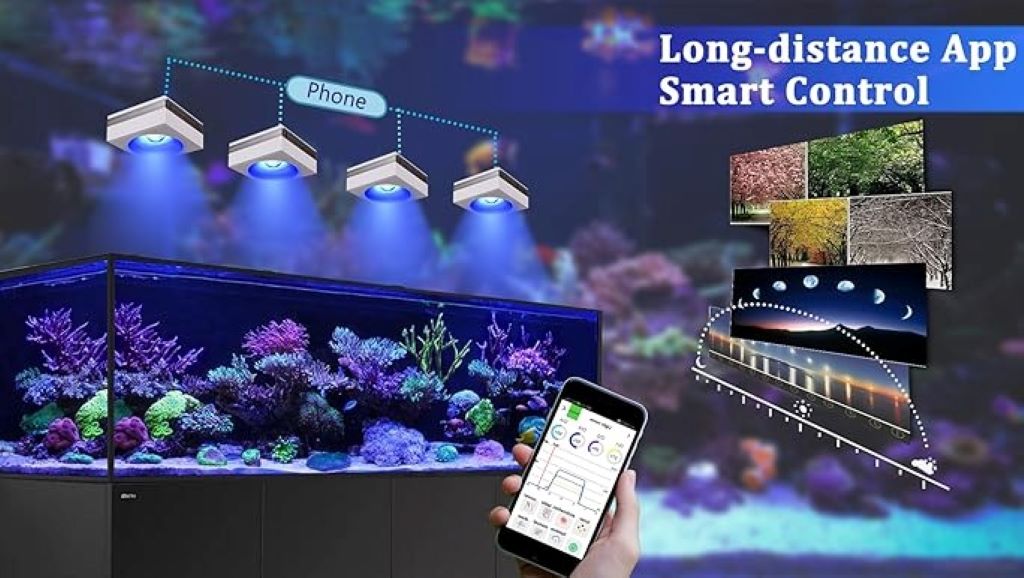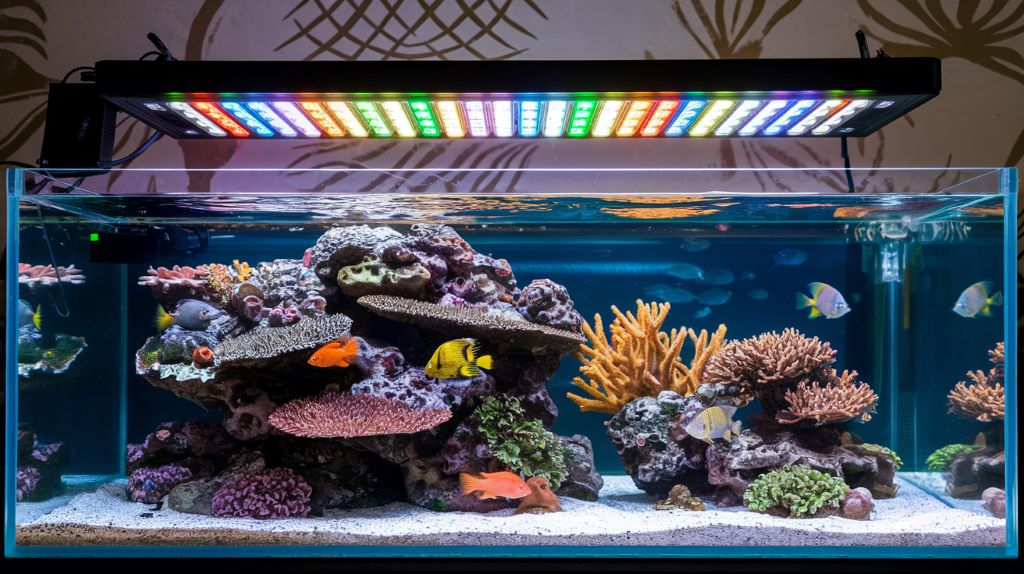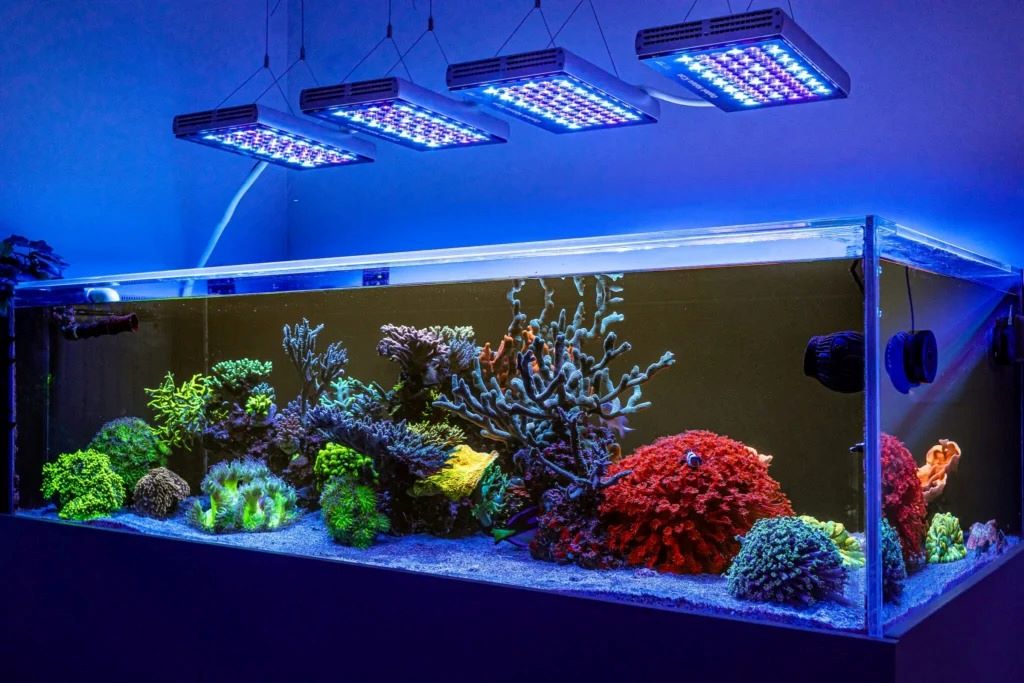The mesmerizing underwater world of a reef tank, teeming with vibrant corals and exotic fish, is a sight to behold. But replicating the sun’s life-giving rays in your home aquarium requires specialized equipment, namely, high-quality reef tank LEDs. With a dizzying array of options flooding the market, choosing the right lighting system can feel like navigating a coral reef itself – full of hidden wonders and potential hazards.
This comprehensive guide will illuminate your path, exploring the best reef tank LEDs for various coral types, from the gentle sway of softies to the demanding needs of SPS. We’ll delve into the science of light, dissect essential features, and review top-rated products, empowering you to make an informed decision and create a thriving reef ecosystem.
Understanding the Spectrum of Coral Needs
Just like terrestrial plants, corals rely on light for photosynthesis. However, the underwater world filters and absorbs light differently, demanding specific wavelengths for optimal growth and coloration. Zooxanthellae, the symbiotic algae residing within coral tissues, utilize specific portions of the light spectrum:
- Chlorophyll a and b: These pigments absorb primarily blue and red light, crucial for photosynthesis and energy production.
- Carotenoids: These pigments absorb blue-green light and contribute to the vibrant colors of corals, acting as photoprotectants against excessive light.
Therefore, your chosen LED fixture should provide a balanced spectrum mimicking natural sunlight that penetrates the ocean depths. This includes:
- Intense blues (400-480nm): Essential for coral growth and fluorescence.
- Full-spectrum whites (6500-10000K): Promote healthy growth and vibrant coloration.
- UV and violet (380-400nm): Enhance coral coloration and fluorescence, but use with caution as excessive UV can be harmful.
Key Features to Consider in Reef Tank LEDs
Beyond the spectrum, several factors influence the effectiveness and suitability of reef tank LEDs:
-
Intensity and Control:
- PAR (Photosynthetically Active Radiation): Measures the usable light energy for photosynthesis. Higher PAR values are generally required for SPS corals, while lower PAR is sufficient for softies and LPS.
- Dimmability and Controllability: Allows you to adjust intensity and spectrum throughout the day, simulating natural sunrise, sunset, and lunar cycles. Advanced systems offer individual color channel control for fine-tuning.
-
Coverage and Spread:
- Lens Design and Optics: Determine the light spread and intensity distribution. Wider lenses provide more even coverage for larger tanks, while narrow lenses focus light for deeper penetration.
- Fixture Size and Shape: Choose a fixture that adequately covers your tank’s dimensions and coral placement.
-
Heat Management and Efficiency:
- Active vs. Passive Cooling: Active cooling systems with fans dissipate heat more effectively, prolonging LED lifespan and preventing overheating of the tank.
- Energy Efficiency: Look for LEDs with high luminous efficacy (lumens per watt) to minimize energy consumption and reduce operating costs.
-
Durability and Longevity:
- Build Quality and Waterproofing: Ensure the fixture is well-constructed and resistant to saltwater corrosion. Look for IP65 or higher ratings for splash-proof protection.
- LED Lifespan: High-quality LEDs should last for 50,000 hours or more, minimizing the need for frequent replacements.
-
Smart Features and Connectivity:
- Wireless Control and Programming: Many modern LED systems offer app-based control, allowing you to adjust settings, create custom schedules, and even simulate weather patterns from your smartphone or tablet.
- Cloud Connectivity and Updates: Some manufacturers provide firmware updates and cloud-based features for enhanced functionality and performance optimization.
Best Reef Tank LEDs Reviewed

Now that you understand the fundamentals, let’s explore some of the top-rated reef tank LEDs on the market, categorized by their suitability for different coral types:
Softies and LPS:
- AI Prime 16HD: This compact yet powerful fixture offers excellent color rendition and controllability. Its wide spread makes it ideal for nano tanks and shallow reef systems dominated by softies and LPS corals.
- Pros: Compact size, excellent color blending, wireless control, affordable.
- Cons: Limited coverage for larger tanks, fan can be noisy.
- Current USA Orbit Marine IC Pro: This versatile LED offers a customizable spectrum and a wide range of control options. Its sleek design and multiple mounting options make it a popular choice for various tank sizes.
- Pros: Stylish design, customizable spectrum, multiple mounting options, good value.
- Cons: Can run hot without adequate ventilation, limited PAR for demanding SPS.
Mixed Reefs:
- EcoTech Marine Radion XR30w Pro G5: This flagship LED fixture delivers exceptional performance and controllability. Its wide spectrum and high PAR output cater to a diverse range of corals, from delicate softies to demanding SPS.
- Pros: High PAR output, excellent spectrum control, wireless connectivity, robust build quality.
- Cons: Premium price point, requires separate mounting arm.
- Red Sea ReefLED 90: This sleek and stylish fixture combines a balanced spectrum with user-friendly controls. Its integrated WiFi and dedicated app offer seamless control and customization.
- Pros: Stylish design, easy setup, good color rendition, integrated WiFi control.
- Cons: Limited individual color control, may require multiple units for larger tanks.
SPS Dominated Reefs:
- ATI Straton LED: This high-performance LED fixture is designed for serious reef keepers. Its powerful output and adjustable spectrum cater to the demanding needs of SPS corals, promoting rapid growth and vibrant coloration.
- Pros: Exceptional PAR output, customizable spectrum, robust build quality, long lifespan.
- Cons: High price point, complex setup, requires external controller.
- Kessil A360X Tuna Blue: This powerful spotlight delivers intense blue light with a narrow beam, ideal for deep tanks and SPS corals requiring high PAR. Its unique shimmer effect creates a mesmerizing underwater aesthetic.
- Pros: High PAR output, deep penetration, beautiful shimmer effect, excellent color rendition.
- Cons: Limited spectrum control, narrow beam angle, can be expensive.
Budget-Friendly Options:
- Nicrew ClassicLED Plus: This affordable LED fixture offers a surprisingly good spectrum and decent PAR output for its price. It’s a great option for beginners or those on a tight budget.
- Pros: Affordable price, decent spectrum, easy to use.
- Cons: Limited controllability, lower PAR output compared to premium brands.
- Hygger Full Spectrum Aquarium Light: This versatile LED fixture offers customizable color channels and a built-in timer. Its adjustable mounting brackets make it suitable for various tank sizes.
- Pros: Affordable price, customizable colors, adjustable brackets, built-in timer.
- Cons: Limited spectrum control, lower PAR output for demanding corals.
Choosing the Right LED for Your Reef Tank
With so many options available, selecting the best reef tank LED can feel overwhelming. Consider these factors to narrow down your choices:
- Coral Types: Identify the types of corals you plan to keep. Softies and LPS have lower light requirements than SPS corals.
- Tank Size and Depth: Larger and deeper tanks require more powerful fixtures with wider coverage.
- Budget: Set a realistic budget and explore options within your price range. Remember that investing in quality lighting can save you money in the long run by promoting coral health and growth.
- Controllability: Determine your desired level of control. Do you need basic dimming or advanced color channel customization?
- Aesthetics: Consider the fixture’s design and how it complements your aquarium setup.
Frequently Asked Questions (FAQ)
-
How many LEDs do I need for my reef tank?
The number of LEDs depends on your tank’s dimensions, depth, and the types of corals you keep. A general rule of thumb is to aim for 30-50 PAR for softies and LPS, and 100-300 PAR for SPS corals.
-
How long should I run my reef tank lights each day?
A typical photoperiod for a reef tank is 8-10 hours. However, it’s crucial to acclimate your corals gradually to prevent light shock. Start with a shorter photoperiod and gradually increase it over several weeks.
-
Can I use freshwater aquarium LEDs for my reef tank?
While some freshwater LEDs might provide basic lighting, they often lack the specific wavelengths and intensity required for optimal coral growth and coloration. It’s recommended to invest in dedicated reef tank LEDs.
-
What is the best way to mount my reef tank LEDs?
Most LED fixtures come with adjustable mounting arms or hanging kits. Ensure the fixture is securely mounted above the tank, providing even light distribution without creating excessive shadows.
-
How do I maintain my reef tank LEDs?
Regularly clean the lenses with a soft cloth to remove salt creep and dust. Inspect the fixture for any signs of wear and tear, and contact the manufacturer if you encounter any issues.
Conclusion
Choosing the right reef tank LEDs is a crucial step in creating a thriving and vibrant coral reef ecosystem. By understanding the science of light, considering essential features, and exploring top-rated products, you can illuminate your underwater world with confidence. Remember to research your specific coral needs, set a realistic budget, and prioritize quality and controllability for long-term success. With the right lighting, your reef tank will become a captivating centerpiece, showcasing the beauty and diversity of the ocean’s most fascinating creatures.
Read More:
Lighting Up Your Reef Tank: A Deep Dive into the World of Aquarium Illumination




